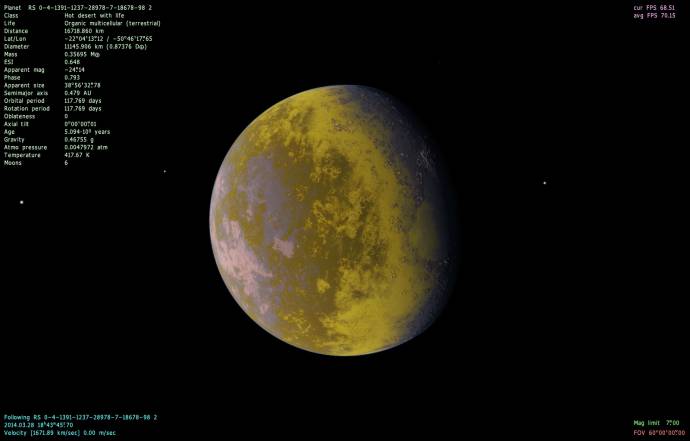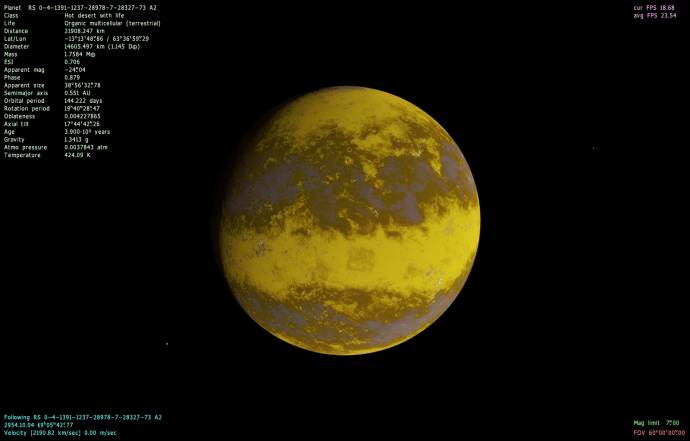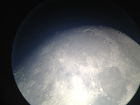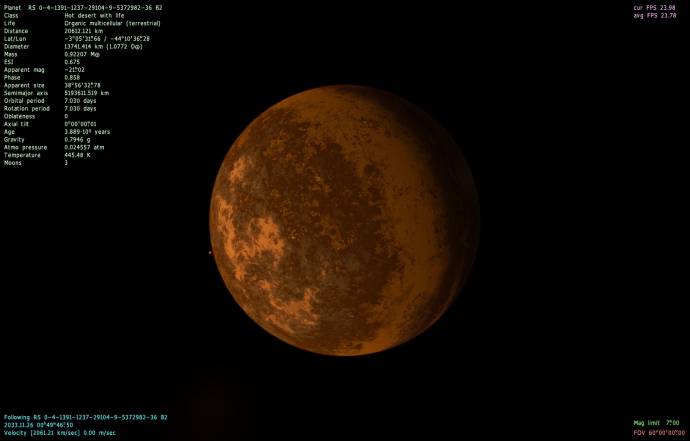|
Challenge: Hottest planet with life
|
|
| Donatelo200 | Date: Tuesday, 21.01.2014, 01:10 | Message # 16 |
|
Explorer
Group: Users
 United States
United States
Messages: 261
Status: Offline
| I found an even hotter planet. No greenhouse as the atmosphere has been more or less ripped off the planet. 

EDIT:
I found one hotter. It's peak observed temperature is 424.09K.

CPU: Intel Core i7-4790K
GPU: Nvidia GTX 1080
SSD: Samsung 850 Evo 250GB
HDD: Toshiba DT01ACA200 2TB
HDD: WD Blue 1TB (2012)
RAM: Unknown 16G-D3-1600-MR 2x8GB
MBD: MSI Z97S SLI Krait Edition (MS-7922)
Edited by Donatelo200 - Tuesday, 21.01.2014, 02:55 |
| |
| |
| DIS7RICT | Date: Tuesday, 21.01.2014, 06:20 | Message # 17 |
 Space Pilot
Group: Users
 Australia
Australia
Messages: 114
Status: Offline
| Quote HarbingerDawn (  ) No; the given temperature includes the greenhouse effect already.
Wow, really? So I only beat lin by the thread of a hair! But too late now, Donatello is back with an even hotter planet, great find!
Quote Watsisname (  ) General note: When you find a candidate hot planet with life, check the temperature through the whole orbit. Perihelion might be significantly different than aphelion.
I guess I should, but if it puts me in the lead on one of my old planets it'll feel like cheating, haha.
PC: Core i7 3770K 3.5GHz, 8GB RAM, GTX670 2GB, Win 7 64-bit
There'll be another time...
Edited by DIS7RICT - Tuesday, 21.01.2014, 06:35 |
| |
| |
| johnson_lin | Date: Tuesday, 21.01.2014, 10:04 | Message # 18 |
 Space Tourist
Group: Users
 Taiwan
Taiwan
Messages: 20
Status: Offline
| So is it OK if I find a "hottest possible temperature" for a given planet? And not restricted to the current time?
Anyhow, I just found this one, although visually not much difference from the last two I posted..

441.39K, and the planet is already at its hottest position. The coldest position's temp is around 405K or so. And I realized why it should not be restricted it to the current time, because most of these planets circle around its sun in an Earth day or two. :P

Edited by johnson_lin - Tuesday, 21.01.2014, 10:06 |
| |
| |
| DIS7RICT | Date: Tuesday, 21.01.2014, 12:35 | Message # 19 |
 Space Pilot
Group: Users
 Australia
Australia
Messages: 114
Status: Offline
| Yes, that's fine, just as watsisname suggested. You are currently in the lead now!
PC: Core i7 3770K 3.5GHz, 8GB RAM, GTX670 2GB, Win 7 64-bit
There'll be another time...
|
| |
| |
| spacer | Date: Tuesday, 21.01.2014, 21:51 | Message # 20 |
 Star Engineer
Group: Users
 Israel
Israel
Messages: 1258
Status: Offline
|  415! 415!
"we began as wanderers, and we are wanderers still"
-carl sagan
-space engine photographer
|
| |
| |
| DIS7RICT | Date: Tuesday, 21.01.2014, 22:31 | Message # 21 |
 Space Pilot
Group: Users
 Australia
Australia
Messages: 114
Status: Offline
| Have you tried seeing how hot that one gets spacer, when it's at it's Perihelion as watsisname suggested?
PC: Core i7 3770K 3.5GHz, 8GB RAM, GTX670 2GB, Win 7 64-bit
There'll be another time...
|
| |
| |
| spacer | Date: Wednesday, 22.01.2014, 06:08 | Message # 22 |
 Star Engineer
Group: Users
 Israel
Israel
Messages: 1258
Status: Offline
| DIS7RICT, oops forgot this.
430! 
"we began as wanderers, and we are wanderers still"
-carl sagan
-space engine photographer
|
| |
| |
| Tangle10 | Date: Monday, 27.01.2014, 02:51 | Message # 23 |
 Space Pilot
Group: Users
 United States
United States
Messages: 129
Status: Offline
| I found an oceania with a MOT of 432.83, but it didn't have life. I could have sworn it did before I went to it... I saw it had life in the f2 dropdown.
Edit: Found winners for the "Ice Giant" and "Gas Giant" Categories! If we have categories! Otherwise they're rather cold! Also, one is barely Earth-Heat!
Tips for finding Earth-Like planets: Look for F, G, or K Class stars. M class habitables will almost always be tidelocked. Oceanias can, of course, also be habitable, they just have tiny amounts of land.
Edited by Tangle10 - Monday, 27.01.2014, 03:05 |
| |
| |
| DIS7RICT | Date: Monday, 27.01.2014, 05:47 | Message # 24 |
 Space Pilot
Group: Users
 Australia
Australia
Messages: 114
Status: Offline
| Quote Tangle10 (  ) If we have categories!
There is now, however just a "Gas planets" and "Rocky planets" category.
PC: Core i7 3770K 3.5GHz, 8GB RAM, GTX670 2GB, Win 7 64-bit
There'll be another time...
|
| |
| |
| Donatelo200 | Date: Monday, 03.02.2014, 22:20 | Message # 25 |
|
Explorer
Group: Users
 United States
United States
Messages: 261
Status: Offline
| Ouch I just stumbled upon a 445.48K planet with life.

CPU: Intel Core i7-4790K
GPU: Nvidia GTX 1080
SSD: Samsung 850 Evo 250GB
HDD: Toshiba DT01ACA200 2TB
HDD: WD Blue 1TB (2012)
RAM: Unknown 16G-D3-1600-MR 2x8GB
MBD: MSI Z97S SLI Krait Edition (MS-7922)
|
| |
| |
| Atheist101 | Date: Monday, 03.02.2014, 23:45 | Message # 26 |
 Astronaut
Group: Users
 United States
United States
Messages: 47
Status: Offline
| I found this one, I dont think its the hottest one on here right now but its pretty hot. Its 411k without much of an atmosphere.
|
| |
| |
| Watsisname | Date: Tuesday, 04.02.2014, 00:54 | Message # 27 |
 Galaxy Architect
Group: Global Moderators
 United States
United States
Messages: 2613
Status: Offline
| Fun to imagine what organic multicellular life might be like on these hot tidally-locked desert worlds.

|
| |
| |
| JCandeias | Date: Tuesday, 04.02.2014, 01:14 | Message # 28 |
 Pioneer
Group: Translators
 Portugal
Portugal
Messages: 387
Status: Offline
| Also floaters, probably. In our own hellish Venus, there's a layer in the atmosphere with conditions of pressure and temperature very similar to those we enjoy right here on Earth. There are plenty of Earth's bacterial microorganisms that could survive there. Had it some oxygen, even some multicellular ones might be able to.
They let me use this!

|
| |
| |
| Watsisname | Date: Tuesday, 04.02.2014, 05:51 | Message # 29 |
 Galaxy Architect
Group: Global Moderators
 United States
United States
Messages: 2613
Status: Offline
| 'Survive', maybe. 'Thrive', probably not. The key issue is water, which is extremely scarce in the Venusian atmosphere and never condenses. Any life there would have to be xerophilic in a way that we don't see anywhere on Earth as far as I am aware. We know of many xerophiles, but they would be better said to be tolerant of low water conditions, usually by going into a form of stasis during times when insufficient water is available.
They would also have to be hyperthermophiles, acidophiles, radiophiles, or some combination thereof. The 'Earthlike' range of temperature/pressure exists in the sulfuric acid haze/cloud layers, above which they would be subjected to harsh UV radiation, and below which they would be subjected to high temperatures. Not an impossible environment, but pretty challenging to be sure. 

|
| |
| |
| neutronium76 | Date: Tuesday, 04.02.2014, 08:07 | Message # 30 |
 World Builder
Group: Users
 Greece
Greece
Messages: 718
Status: Offline
| Quote DIS7RICT (  ) Quote Watsisname ()
General note: When you find a candidate hot planet with life, check the temperature through the whole orbit. Perihelion might be significantly different than aphelion.
I guess I should, but if it puts me in the lead on one of my old planets it'll feel like cheating, haha.
That's why planets for this challenge should be limited to those with circular orbits.
PC1:Core i7 970@3.34GHz, 6 cores/12 threads, 12GB DDR3 RAM@1.34GHz, 2x(SLI) GTX-580 GPUs 3GB VRAM(GDDR5)@1GHz, OS:Win7x64SP1
PC2:Core2Quad X9770@3.2GHz, 2 cores/4 threads 4GB DDR2 RAM@1GHz, GTX-285 GPU 1GB VRAM(DDR3)@1.24GHz, OS:WinVistax64SP2
|
| |
| |